by chris ayres | Dec 2016 | UK to New Zealand
I have been back here In Panama for about 2 weeks. The “black pig” my travel bag somehow didn’t fly with me on the last stretch from Mexico City to Panama so this was worrying for a few days until it finally turned up. Arriving here the temperatures was in the 30’s, a bit of a shock after cold England it it took me a few days to get acclimatized but nevertheless great to just pull a pair of shorts and a vest on and have done with it.
Sea Bear was fine though hot as an oven from being shut up for so long.
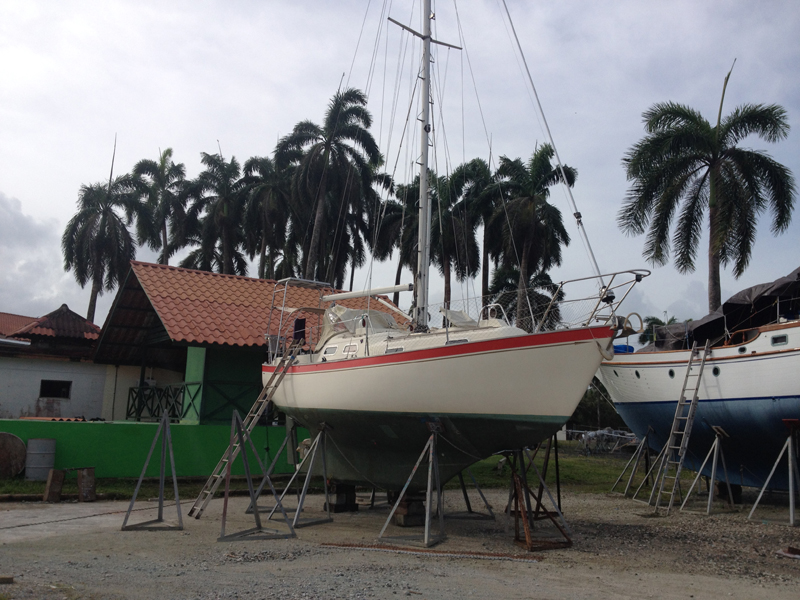
Sea Bear at Shelter Bay
So began the task of fitting out, slow going in the heat and a few problems arose. One a crack in the heel of the keel which had to be ground out and repaired. Turns out a few Vancouver 28 have suffered this fault, the two part s are just glued together and not bonded over with glass fibre. Fortunately my crack turned out to be just a surface crack so no water ingress in the moulding.
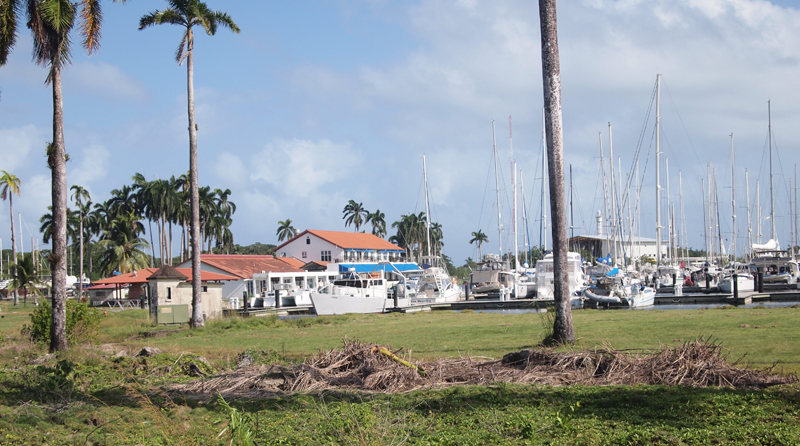
Shelter Bay marina
The boat yard here is surrounded by jungle.On Christmas day I had a short walk, I didnt see any jaguars, sloths or toucans but did see Nasua Narica, a monkey, Great Kisadees, Tropical King bird, hummingbirds, Greater Ani and Vultures, beautiful in flight but ugly and awkward on the ground.
Hoping to relaunch in a few more days.
by chris ayres | Jan 2017 | UK to New Zealand

Finally Sea Bear was re-launched on 3rd January, it felt great to be back in the water. Felt it was time to get sailing again, a few little jobs to finish off but then a set back and had a disaster afternoon.
There was a drain valve at bottom of fuel tank just checking things over looked like it was leaking a bit, investigating and it fell off in my hand so there I was laying in engine bay with my finger stopping the hole where once the valve was. Like the Dutch boy and the dam trying to stop 30 gals of diesel pouring into the bilges Mmm I thought! Anyway someone heard me shouting and came to help so I was able to tell them where a wooden plug and a hammer was so hammered the plug in the hole.
The reducer between tank and valve had been just a mild steel fitting, not fit for purpose at all and had just corroded away. Lucky that it had happened here where I was able to fix it and not somewhere out at sea
Spent rest of afternoon chasing someone down as I need to empty fuel tank so need big drum and pump etc. Eventually all organised and next morning the tank was pumped out, fitting replaced with new valve and tank refilled.
So planning to set of in the morning, just a short hop up the coast to either Portabelo or Isla Linton.
I will also switch on the Yellow Brick Tracker so there should appear a live position of the boat on the current position page.
by chris ayres | Jan 2017 | UK to New Zealand
I eventually got away from Shelter Bay on 6th Jan, winds14-16 knots just right for a shake down sail and seas outside the breakwater after playing dodge the shipping, not too bad. However it took a long time to make Portobello, against wind and current with a few tacks thrown in, about 8 hours for 29 logged miles when the nominal distance is just less than 20. The clearwater buoy marking the entrance to the bay had disappeared since June, probably a victim of Otto and in the bay there were several wrecked boats, Otto being the late season hurricane that had hit the coast further north, the latest and furthest south hurricane ever recorded.
Another teething problem surfaced, this a hole in the heads outlet pipe spraying out dirty water! Though how a hole had suddenly appeared in a 4mm thick reinforced pvc pipe beats me. Shortening the pipe by cutting of the end fixed it but what a struggle to get the pipe back on – took about 3 hours!
Next day the strong winds returned, that have been an almost constant feature since arriving back in Panama. Unless these ease i will not have much chance of making San Blas. After a few days in Portobello I headed of for Isla Linton, just 8 miles away but by the time I arrived logged distance was 19 miles and time taken 5 hours. So much for beating into strong winds and big seas. The entrance was spectacular between surf on the reef on one hand and crashing waves on the rocks on the other hand.
In the morning I dinghied across to the island, didn’t make much progress into the jungle though. Returning towards the beach I was just sheltering from a rain shower under a Palm tree turned around and there were 2 monkeys sitting behind me not 2 feet away. They walked with me back to the beach, I was amazed at how upright they walked. One grabbed me around the legs, I was just a bit wary as had been warned they sometimes bite and one was obviously thinking of some monkey business.

Puerto Lindo

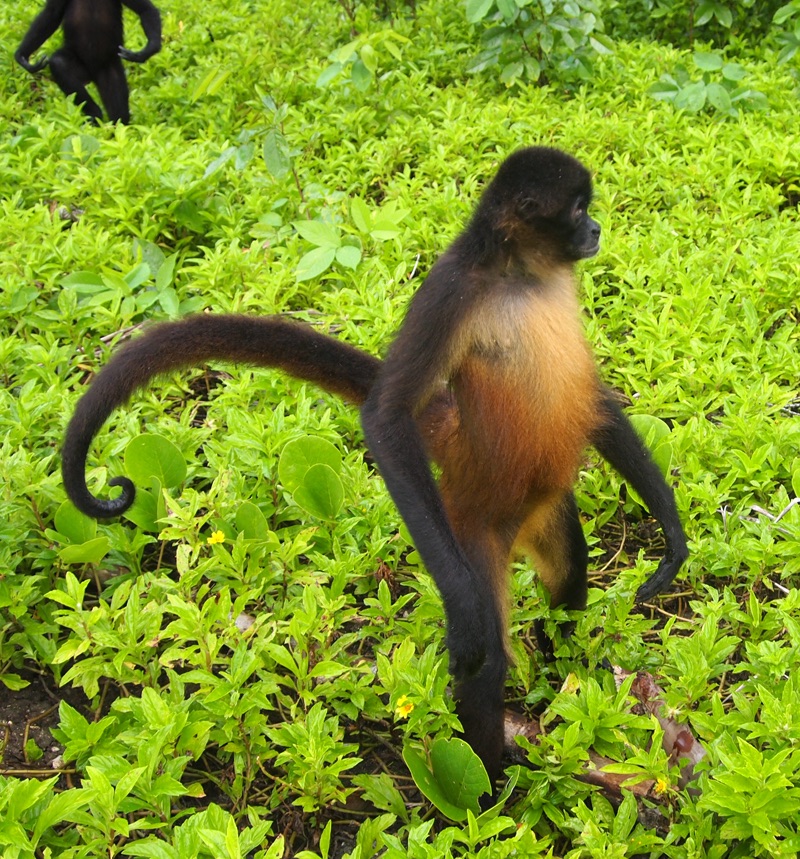
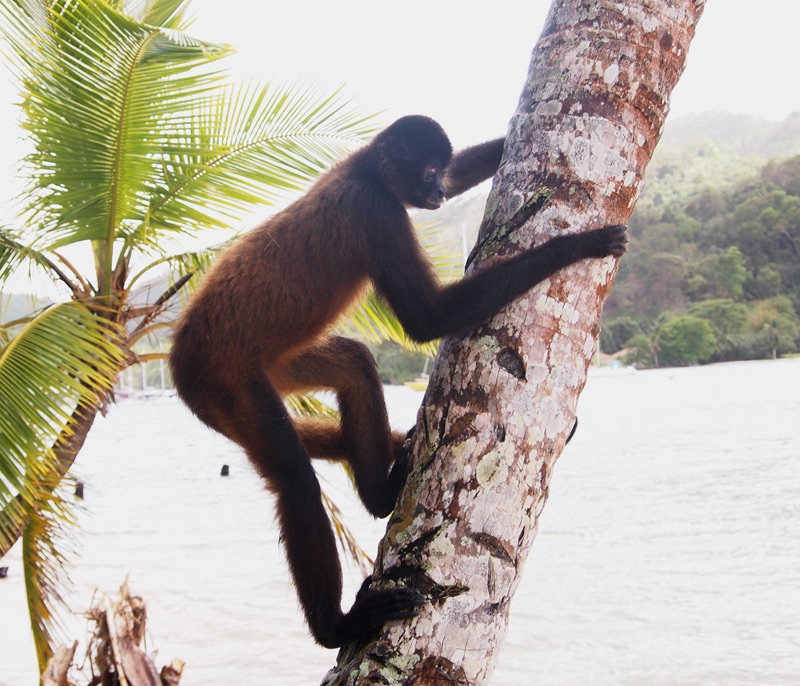

Isla Linton
Whilst at anchor here the weather continued unsettled, always strong winds, some heavy rain squalls and one knew the waves outside would be big.
by Chris | Feb 2017 | UK to New Zealand
Before leaving Portobello I had completed and emailed in form 4405-i, the first step in registering your boat in the Panama canal system and requesting a transit.
Initial enquiries about getting a new exhaust elbow in Panama seemed to suggest I might have to wait 2 weeks but I found a guy in America who made them in Stainless steel so I ordered one from him. It took a week, 3 days to get from Virginia to Panama City via New York then 4 days to get from Panama City the 70 k to Colon, where I collected it from the Post Office. That was quite an experience in itself, 3 different counters to visit and different forms to fill and sign for then the packet was given to the Customs official who spent most of time sitting dozing on a chair who opened it to check that its contents matched the description on the customs form.

new ss exhaust elbow
That same day I also visited Citibank to check that they had received my canal transit fees through wire transfer and completed the last bit of paperwork. On to the supermarket for more provisions, stocking up for the long haul. Back at the boat the new exhaust elbow fitted and the engine run up – all good to go.
Earlier in the week I had arranged for an admeasurer from the canal to come and measure the boat and had completed all the necessary forms to request a handline transit of the canal.
The final step was to phone up the scheduler for a transit slot. I was given Friday 17th Feb.
I will have to be at the Flats anchorage to pick up my transit advisor at 14.00 then shortly afterwards motor the 4 miles to the Gatun locks. After the 3 locks you moor up for the night in Gatun lake before resuming the rest of the transit the next morning.
With a date assigned I phoned Tito to hire the necessary lines – 4 x 150ft 7/8 to 1”lines and heavy duty fenders. Now to find 4 linehandlers. If the canal webcams are working you might spot me in the Gatun locks sometime after 16.00 Panama time (Thats 21.00 UK time)
by chris ayres | Jan 2017 | UK to New Zealand
Eventually the winds eased so more favourable for making the passage eastwards. Weighing the anchor I passed out of the bay and took good care to keep clear of the unmarked Lavandra Reef. A long tack north out to sea then I could tack east. I think 15 knots is my favourite sailing breeze, light enough to set all plain sail, not too strong to kick up much of a sea but strong enough to make reasonable progress.
By early afternoon I was in the vicinity of Green Turtle bay so I put in here and anchored awhile. It was as I expected too rolly to stay but I could prepare a meal before weighing anchor early eve and set off for a night passage.
Another long tack northwards away from the coast before tacking east again. The trick I find is to be far enough offshore not to worry about inshore shoals and danger but not too far so you are playing with the big boys, the tankers and container ships. Dawn saw me within sight of Punta San Blas. I had planned on anchoring at Chichame Cays but on approach it looked a bit crowded so carried on. However aiming for the Eden Channel I got a bit of a scare when I got the islands confused, went off line and strayed over a shoal patch. Maybe I was to tired and dim witted after the night passage with no sleep . I headed back to Chichame, entered the lagoon it was busy but enough room and anchored, time for some rest.
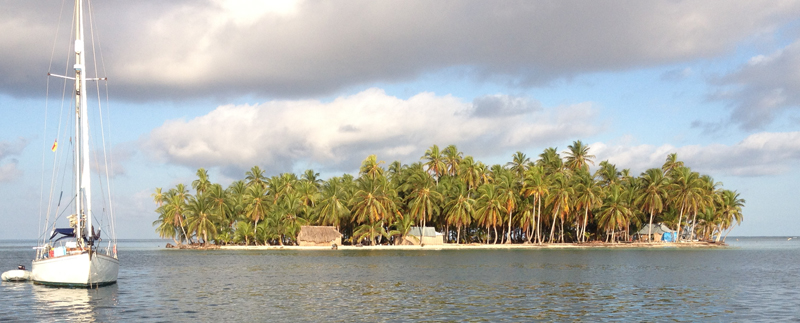
Beautiful though it was here, sandy palm treed islands, it was a bit like westerners doing their being on holiday thing. So next day I went in search of the real Guna Yala. I anchored off the island of Acuadup. Ashore was a traditional Guna village, palm leaf thatched huts, Guna indians in native dress, lots of dugout canoes. I bought some bread.

Moving on next day I passed through the well populated and busy Carti islands. I was put off anchoring here as you anchor in 17 m and have you ever tried pulling up min 3×17 m of 8mm chain and an anchor by hand? ( total wt about 85 kilos in case your wondering) Well I didn’t fancy it one bit.

one of Carti Islands
I went to Soledad Mira another traditional village and anchored. Unfortunately the holding here was not good, anchored on a small sloping boulder shelf, so left after a while and went to Los Grullos, anchoring off Kuandiup, just another sandy palm tree island. There was a Guna restaurant here so treated myself to a fish dinner.

Kuanidup

On to Mokame, a populated traditional island. Here I spent some time talking with a Guna guide who told me of some of their traditions, beliefs, and of the shaman and showed me around the village, the meeting hut or congresso, his hut and his Nuchus, small carved wooden statutes a link between the physical and spiritual side.
They live on the islands because they are free from insects and other things in the jungle on the main land but the tend gardens in the jungle for their produce paddling over there in their dugout canoes.


lobster man
Lobster for dinner bought from a free diver.
On then to Salardup an island in the Naguarandup Cays, a group of mostly uninhabited islands scattered along a 6 mile long barrier reef, further offshore than the inhabited islands. Salardup is in a lagoon approached through a gap in the surrounding reef. None of the reefs in the San Blas are marked, mark one eyeball navigation is required spotting the colour of the water to show you the depth.
I completed a circumnavigation of sorts of the Naguarandup Cays, sailing down the inland channel then out past Kanlildup or Green Island towards the Coca Bandera Cays then back westwards to the Lemmon Cays to anchor between three islands with a very shallow approach. A long days sailing through beautiful islands, so many islands.

by Chris | Feb 2017 | UK to New Zealand
I left Lemmon Cays soon after first light, as soon as the light was good enough to see the reefs. Out past the reefs and breaking surf I could set a course to clear the reefs of Porvener. A close reach this wind about 20 knots and a reasonably lively sea. I chose to get enough northing in to clear all offshore dangers meaning I could run down my westing free in that knowledge, rather like the old time clippers used to do. Once out at 9 degrees 38 minutes I turned westwards, putting Sea Bear on a beam reach and she fairly romped along. Much later the average speed on the log was showing 6.1 knots, good going indeed for us.
Rounding Isla Tamba and Isla Grande we were in good time and so instead of going in to Isla Linton to anchor I carried on to Portobello. The wind had eased a little over the last hour but rounding Drake Island and within sight of the anchorage with the log showing 60 miles covered in 10 hours, it died completely. No problem I thought I’ll just motor the last mile to anchor, but problem there was. The engine did not start, it would not even turn over but was locked solid. An initial assessment showed me that it wasn’t something I could fix right then. With wind I could have sailed in but there was none. I called up some cruisers in the bay over the vhf and explained my position so they said they would come out in their dinghies and assist. Before they arrived though a little breeze came back so I sailed towards the anchorage, the dinghies dully arrived and shepherded me to anchor. I was grateful for their support.
Safely at anchor it was out with the tools, out with the injectors, off with the exhaust elbow and drain all the seawater out of the engine and crank by hand to blow the remains out. Put it all back together and mercifully the engine started and ran. I warmed it up to drive out any moisture lingering. Finished well after dark and then I could make a cuppa and cook dinner. Puzzling over why this had happened I investigated further and discover the air inlet pipe to the anti-syphon valve was blocked, allowing sea water to syphon in to the exhaust manifold and thence the engine, Easily solved that but worse was that the exhaust elbow was corroded inside – only cure for that a new one.
Spent a couple of day at Portobello then headed off to Shelter Bay, turned out to be a very windy day and approaching the breakwater rain squalls too. Dodging both and outgoing and ingoing big ships I entered the breakwater and so to moor alongside in Shelter Bay marina. Time to try and get a new exhaust elbow and start with the canal paperwork.
Page 15 of 24« First«...10...1314151617...20...»Last »
















